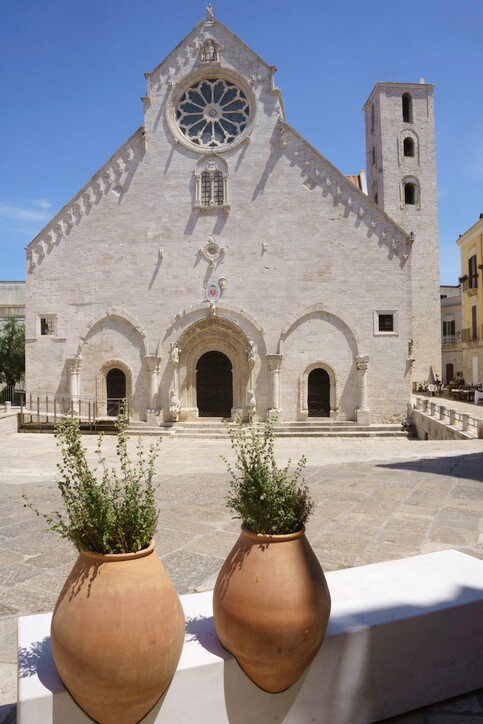Bari
Bari is the main city in Puglia and has a great history. Bari is a part of Puglia area south-east of Italy, Bari is reckoned to be the main city in the area. When you plan a trip to Italy, Bari is probably not the first thing that pops into your head. But if you are looking for a place with historical buzz, where you also can enjoy your days at a slower pace, than in the big cities, then Bari may be the right place for you.
Top Attractions in Bari, Italy
1. Basilica San Nicola
There’s no doubt why Basilica San Nicola comes first on this list. It was built a thousand years ago and is Bari’s major religious, historical, and spiritual center. The pilgrimage church is one of the finest achievements of Romanesque architecture in Apulia. In addition, it is considered to be the most popular tourist attraction in Bari.
2. Castello
Found on the west side of the old town, Castello (castle) is originally a Byzantine-Romanesque building. It was converted into a palace by Bona Sforza in the 16th Century. Later, the palace was used as a prison and signal station. Today, Castello has an interesting museum found inside with copies of Apulian-Norman sculptures and a temporary art exhibition
3. Pinacoteca Metropolitana di Bari
Pinacoteca Metropolitana di Bari is an old-fashioned little art museum found in the center of Bari. You can find historical paintings and artifacts, where you can also learn about the city’s history. The museum is open from Tuesday to Sunday from 9 am to 7 pm.
4. Piazza del Ferrarese
Piazza del Ferrarese is considered to be the center of Bari. It has a unique mix of the old and new worlds to find different restaurants and bars. Aside from its marketplace and entertainment, travelers can also enjoy the old architecture.
5. Ancient City of Egnazia
Egnazia can be found southeast of Bari. The ancient city dates back to the 13th century B.C. when Bronze Age settlers were here. There are archaeological areas where signage is written in English. They can be found in the city, necropolis, and acropolis. Many of its ancient structures are still standing. The exact location is in Strada Provinciale Savelletri Capitolo, Bari.

Bari pleasure by the sea
Bari is a port city with ferries to Greece and Albania. Its location at the entrance to the Adriatic Sea puts the region and Bari in a special historical position. The city has been an important trading post and has been the subject of several conflicts throughout history, due to its attractive location. Today, Bari is a city with its own university and plays a role as the capital of the economy of mainland southern Italy along with Naples. Facing the Adriatic sea is Bari, the second-largest city in Southern Italy. What used to be a quiet and empty port is now crowded with ships as it is a commercial, agricultural, and industrial center. Widely and immensely popular amongst tourists are its narrow streets lined with picturesque architecture and famous historic attractions. Archeological evidence suggests that Bari was first settled in the Bronze Age, around 2000 BC. Inhabitants were believed to be originally Illyrian followed by the Greeks and finally the Romans during the 3rd Century BC.
Furthermore, Bari’s harbor was mentioned as early as 180 BC as a principal Harbor during ancient times. Likewise, modern-day Bari is a popular harbor and a center of fishery. During the Roman era, Bari was a direct path between the coast roadway and the Via Traiana and was likely focused on the fishery. As a result, the new road made its way from Roma to Brindisi more quicker. As a result of the fall of the Roman Empire, Bari changed sides throughout the years, putting it under the control of either Lombards or Saracen. In 1025, Bari became a center of Catholicism as it was granted provincial status by Rome.
In 1087 Basilica di San Nicola was founded to hold the remains of Saint Nicolas. Pilgrims flocked to visit and proved to bolster the city’s economy. Afterward in 1098, the Council of Bari convened to resolve disputes between two Christian Churches. Ultimately their differences eventually resulted in the Great Schism. Bari’s prominence as an important city of Catholicism rose.
Under Longobard’s rule and after the devastations of the Gothic Wars, A set of written regulations was created. Widely known as the Consuetudines Barenses, other written constitutions in southern cities were influenced and were centered around it. Bari continued to be governed by Longobards and Byzantines up until the Normans arrived. In the 11th century, Norman Robert Guiscard arrived in Bari and started his campaign to capture Southern Italy. The war with the Byzantines had lasted for several years and during grueling times Bari had to endure a 3-year siege.
Finally, Robert Guiscard conquered the city and became the King of Southern Italy. Bari would then be under the rule of the Normans. Later on, a massive fortress would be constructed by Norman King Roger the 2nd. Its purpose was to keep Bari protected from more enemy attacks; an impenetrable castle over the sea surrounded by deep moats was created.
At the start of the 12th century, a war in southern Italy had broken out led by the King of Sicily William the Bad. Bari was captured and the city was ruined in the process. Years later Emperor Frederick the 2nd would rebuild Bari and reconstruct the fortress of Castell Svevo. Aside from the various conflicts that occurred, several other religious monuments were constructed during the middle ages, especially Cattedrale di Bari. It served as a central area and was surrounded by the city’s most beautiful plazas.
Throughout the middle ages, Bari had a terrible reputation as a popular slave market and it serves as one of the major slave depots of the Mediterranean, providing a central location for the trade in Slavic slaves. Bari would remain under the rule of Naples for several centuries up until 1860.
In 1860, the city was unified along with the rest of the kingdom of Italy. Napoleon’s general Joachim Murat had decided to build a new modern district and expand Bari In the 19th century, Plans for new sections of the city were personally designed by him. After this time, industrialization and urbanization occurred and resulted in the modern metropolis of Bari today.
19th Century Bari underwent a rapid increase in population and industrial development. The city expanded far beyond what were once the city walls. Apart from industrial development was the creation of archeological museums, a picture gallery, and the University of Bari founded in 1924. In 1930 the annual Fiera del Levante has first held in Bari an Occidental-Oriental trade fair.
The city suffered damage in World War II. Namely, it suffered the effects of chemical warfare and aerial bombardment. Since then the city has been rebuilt and long recovered. Modern-day Bari consists of newly erected residential, commercial, industrial, and two of its own airports. Today the city is widely known as the “California of the South”, and it has all the things a city could ever need.
History of Bari

Churches and Basilica
The basilica is dedicated to Saint Nicholas, which played a very much part in the identity of Bari. It shelters and venerates the relics of St. Nicholas, who is also the patron saint of Bari. It is also a pilgrimage destination for both Roman Catholic and Orthodox Christians.
The Chiesa di San Giuseppe or Church of St. Joseph was founded in the eighth Century. It was built by the Roman noblewoman Dottula in honor of the Madonna, and it was later consecrated to St. Joseph. The Church has a Greek cross plan and houses two small marble altars in the two sidearms.
Pinacoteca Metropolitana di Bari is an old-fashioned little art museum found in the center of Bari. You can find historical paintings and artifacts, where you can also learn about the city’s history. The museum is open from Tuesday to Sunday from 9 am to 7 pm.
Chiesa San Marco dei Veneziani is considered one of Bari’s most fascinating religious structures, with Romanesque architecture resembling an ordinary hut. Visitors can find an 18th-century altar, statues of Saint Anthony, Saint Mari dei Pozzo, and a beautiful rosette.
The construction of this Church is linked to the liberation of Bari by the Saracens. The building dates back to the 11th Century and was located on Via Francigena, one of the liveliest arteries of ancient Bari. It is a church of great architectural interest due to the mixture of different cultures and ethnic groups linked to the city’s historical events.
